

The Palazzo Beneventano del Bosco is a large urban palace, located on piazza Duomo, across from the present city hall and diagonal to the Cathedral of Syracuse, in the island of Ortigia in the city of Syracuse in Sicily, Italy.


The Palazzo Beneventano del Bosco is a large urban palace, located on piazza Duomo, across from the present city hall and diagonal to the Cathedral of Syracuse, in the island of Ortigia in the city of Syracuse in Sicily, Italy.
A palace at the site dates from the Middle Ages, when it was constructed for the Arezzo family. However, damaged by the 1693 Sicily earthquake, following its purchase by Baron Guglielmo Beneventano, the palace was rebuilt mainly between 1779 and 1788 in the Sicilian Baroque style.
Beneventano commissioned the design from the architect Luciano Alì, who transformed the medieval building, which had been used as a seat of local government, into a private house. Built around an enclosed courtyard, the internal courtyard has canted facades are adorned with twin columns, putti, and statuary, that accentuate the surface complexity with chiaroscuro.
The ornate design continues into the interior with sculptures by a Palermitano artist, Lombardic Gregorio, and frescoes by Ermenegido Martorana. To further create the air of fantasy and extravagance, huge crystal chandeliers were imported from Murano. The interior of the palazzo is not open to the public but can be viewed by special permission from the owners.

Syracuse is a historic city on the Italian island of Sicily, the capital of the Italian province of Syracuse. The city is notable for its rich Greek and Roman history, culture, amphitheatres, architecture, and as the birthplace and home of the pre-eminent mathematician and engineer Archimedes. This 2,700-year-old city played a key role in ancient times, when it was one of the major powers of the Mediterranean world. Syracuse is located in the southeast corner of the island of Sicily, next to the Gulf of Syracuse beside the Ionian Sea. It is situated in a drastic rise of land with 2,000 metres (6,600 ft) depths being close to the city offshore although the city itself is generally not so hilly in comparison.

Noto is a city and comune in the Province of Syracuse, Sicily, Italy. It is 32 kilometres (20 mi) southwest of the city of Syracuse at the foot of the Iblean Mountains. It lends its name to the surrounding area Val di Noto. In 2002 Noto and its church were declared a UNESCO World Heritage Site.
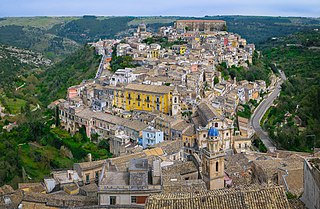
Ragusa is a city and comune in southern Italy. It is the capital of the province of Ragusa, on the island of Sicily, with 73,288 inhabitants in 2016. It is built on a wide limestone hill between two deep valleys, Cava San Leonardo and Cava Santa Domenica. Together with seven other cities in the Val di Noto, it is part of a UNESCO World Heritage Site.

The Province of Syracuse was a province in the autonomous island region of Sicily in Italy. Its capital was the city of Syracuse, a town established by Greek colonists arriving from Corinth in the 8th century BC. It had an area of 2,109 square kilometres (814 sq mi) and a total population of 403,985 (2016). Syracuse had 8% of the Sicilian population and 8.2% of Sicily's area.

Sicilian Baroque is the distinctive form of Baroque architecture which evolved on the island of Sicily, off the southern coast of Italy, in the 17th and 18th centuries, when it was part of the Spanish Empire. The style is recognisable not only by its typical Baroque curves and flourishes, but also by distinctive grinning masks and putti and a particular flamboyance that has given Sicily a unique architectural identity.

Palazzolo Acreide is a town and comune in the Province of Syracuse, Sicily. It is 43 kilometres (27 mi) from the city of Syracuse in the Hyblean Mountains.

Giuseppe Venanzio Marvuglia was an Italian architect.

Scicli is a town and municipality in the Province of Ragusa in the south east of Sicily, southern Italy. It is 25 kilometres (16 mi) from Ragusa, and 188 kilometres (117 mi) from Palermo, and has a population (2017) of 27,051. Alongside seven other cities in the Val di Noto, it has been listed as one of UNESCO's World Heritage Sites.
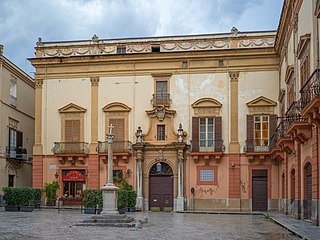
Palazzo Valguarnera-Gangi is an urban palace, first of the Princes Valguarnera and then of the Princes Gangi, situated in the Piazza Croce dei Vespri, in the ancient quarter of the Kalsa in the city of Palermo, region of Sicily, Italy. The palace still retains its original rich Rococo interior decoration, and is located a block south of the church of Sant'Anna la Misericordia.

Palazzo Corvaja is a medieval palace in Taormina, Sicily, Italy. It was principally built at the end of the 14th century and is named after one of the oldest and most famous families of Taormina, which owned it from 1538 to 1945.

Gothic architecture appeared in the prosperous independent city-states of Italy in the 12th century, at the same time as it appeared in Northern Europe. In fact, unlike in other regions of Europe, it did not replace Romanesque architecture, and Italian architects were not very influenced by it. However, each city developed its own particular variations of the style. Italian architects preferred to keep the traditional construction methods established in the previous centuries; architectural solutions and technical innovations of French Gothic were seldom used. Soaring height was less important than in Northern Europe. Brick rather than stone was the most common building material, and marble was widely used for decoration. In the 15th century, when the Gothic style dominated both Northern Europe and the Italian Peninsula, Northern Italy became the birthplace of Renaissance architecture.

Palazzo degli Elefanti is a historical building in Catania, region of Sicily, southern Italy. It currently houses the city's Town Hall. In the past, the prior building was also known as the Palazzo Senatorio or Loggia Senatoria.

The Sicilian Regional Assembly is the legislative body of Sicily. While it has a long history as an autonomous entity, the modern Region of Sicily was established by Royal Decree on 15 May 1946, before the Italian Republic. The Regional Assembly has the widest legislative power in Italy and is the only regional assembly to have the title of "parliament" whose members are called "deputies" as are those in Rome. Seventy deputies are elected every five years in the nine provinces.

Piazza Stesicoro is a rectangular city square in the historic center of the city of Catania, in Sicily, Italy.
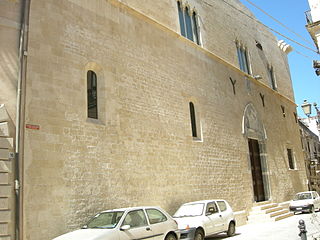
Bellomo Palace Regional Gallery is an art museum in Syracuse, Sicily.

The Palazzo dell'Università or Palazzo Centrale dell'Università di Catania is a monumental palace located in Piazza Universitaria, in the center of the city of Catania, region of Sicily, southern Italy. Since its construction, it has housed the main offices of the University of Catania, and stands across the piazza from the Palazzo San Giuliano, also housing offices of the university. It presently houses the offices of the rector, university offices, the "Giambattista Caruso" Regional Library, and a small museum of geology and archeology.
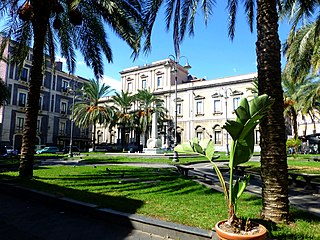
The Palazzo Cutelli is a historic palace, once housing the Collegio Cutelli, now the semiprivate Convitto Cutelli, a boarding school from primary to lyceum grades, located on Via Vittorio Emanuele #56 in central Catania, region of Sicily, Italy.

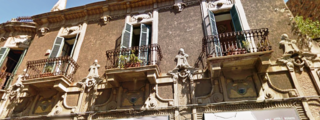
37°03′36″N15°17′34″E / 37.06000°N 15.29278°E